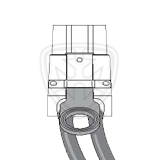Description
SummitStack™ allows multiple physical switches to be connected and managed as a single unit with a single IP address. This reduces complexity and enables easier management, while providing a flexible way to increase density, capacity and port configuration choices, while controlling initial capital expenditure.
How it Works
SummitStack stacking technology allows customers to physically connect up to eight individual Summit® X250e, X440, X450a, X450e, X460, X480, X650, X670 or E4G 400 switches together as a single logical unit. This logical unit reduces the management overhead of fixed configuration switches by behaving as a single switch with a single IP address and a single point of authentication.
In ExtremeXOS®, the Extreme Networks edge-to-core modular operating system, a stack is controlled by a master switch, called the master. The master switch runs the full-featured version of ExtremeXOS and is responsible for maintaining all of the software tables for all the switches in the stack. There can only be one master switch in a stack of switches. All switches in the stack, including the master switch, are called nodes.
A SummitStack can be thought of as a Virtual Chassis™. Each node acts as if it was occupying a slot in a chassis and is controlled by the master. The high-speed stacking links function like the backplane links of a chassis. Stacking offers customers a flexible way to increase switch density and capacity, provides port configuration choices, and controls upfront capital requirements. SummitStack permits mixing and matching Summit switches in a stack to provide the port configuration you need, from Ethernet to Fast Ethernet, Gigabit Ethernet, 10 Gigabit Ethernet and 40 Gigabit Ethernet, in copper, Power over Ethernet (PoE or PoE-plus) and fiber interfaces.
Summit Stack Topologies
The figure below presents a graphical representation of a stack and some of the terms that describe stack conditions. A stack is the collection of all nodes that are cabled together in a stack. A stack topology is the set of contiguous nodes that are powered up and communicating with each other. Switch 8 is not part of the stack topology in the figure because it is not powered up. An active topology is the set of contiguous nodes that are active. An active node is powered up, configured for SummitStack operation, and communicating with the other active nodes. Switch 5 in the figure has failed, and stacking is disabled on Switch 6 and Switch 7. Switch 8 has no power, so the active topology includes switches: Switch 1, Switch 2, Switch 3, and Switch 4.

